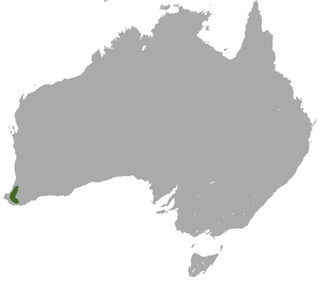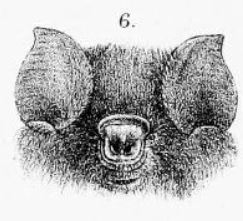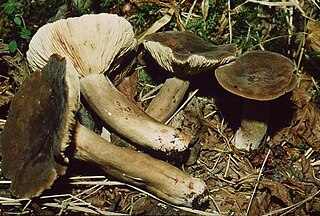
The western grey kangaroo, also referred to as a western grey giant kangaroo, black-faced kangaroo, mallee kangaroo, and sooty kangaroo, is a large and very common kangaroo found across almost the entire southern part of Australia, from just south of Shark Bay through coastal Western Australia and South Australia, into western Victoria, and in the entire Murray–Darling basin in New South Wales and Queensland.

Wandering spiders (Ctenidae) are a family of spiders that includes the Brazilian wandering spiders. These spiders have a distinctive longitudinal groove on the top-rear of their oval carapace similar to those of the Amaurobiidae. They are highly defensive and venomous nocturnal hunters. Despite their notoriety for being dangerous, only a few members of Phoneutria have venom known to be hazardous to humans, but the venoms of this family are poorly known, so all larger ctenids should be treated with caution.

The sooty oystercatcher is a species of oystercatcher. It is a wading bird endemic to Australia and commonly found on its coastline. It prefers rocky coastlines, but will occasionally live in estuaries. All of its feathers are black. It has a red eye, eye ring and bill, and pink legs.

The dusky caenolestid, also known as Tate's shrew opossum, is a shrew opossum from South America. The dusky caenolestid is characterized by a dark brown coat with a lighter underbelly, soft and thick fur, and a loosely haired tail. A nocturnal animal, the dusky caenolestid lives on trees and feeds on insects and small invertebrates and vertebrates. It occurs in alpine and páramo forests in northern and western Colombia, Ecuador, and western Venezuela. The IUCN classifies this shrew opossum as least concern.

The lava gull, also known as the dusky gull, is a medium-sized gull and a member of the "hooded gull" group. It is most closely related to the Laughing gull and Franklin's gull and is the rarest gull in the world. It is endemic to the Galapagos Islands.

Myrmecotypus is a genus of ant mimicking corinnid sac spiders first described by O. Pickard-Cambridge in 1894. Species mainly occur from Panama to Mexico, with one species found in the United States, and one in Argentina.

The sooty dunnart is a species of dunnart found in Western Australia. It is one of the least-known of the dunnarts, with the IUCN classifying it as data deficient. It was formerly believed to be a subspecies of the common dunnart.
The Palawan scops owl is an owl endemic to Palawan in the Philippines. There are no subspecies besides the nominate.
Cycloramphus fuliginosus is a species of frog in the family Cycloramphidae. It is endemic to southeastern Brazil and known from the Atlantic coastal forest between southeastern Bahia and Rio de Janeiro. Its common name is Tschudi's button frog. The specific name was originally spelled as fulginosus, but the incorrect subsequent spelling fuliginosus by André Marie Constant Duméril and Gabriel Bibron (1841) was followed by later authors and is now preserved on the basis of the "prevailing usage".

The sooty bushtit is a species of bird in the family Aegithalidae. It is endemic to central China.

The striated fieldwren is a species of bird in the family Acanthizidae, endemic to Australia.

The sooty roundleaf bat is a species of bat in the family Hipposideridae. It is found in Cameroon, Democratic Republic of the Congo, Ivory Coast, Gabon, Ghana, Guinea, Liberia, Nigeria, Sierra Leone, and Uganda. Its natural habitats are subtropical or tropical moist lowland forests and moist savanna. It is threatened by habitat loss.

Apostictopterus is a genus of skippers in the family Hesperiidae. It contains only one species, Apostictopterus fuliginosus, which is found in India (Assam) and West China.

The sooty grunter, also known by the name black bream, blubberlips, Northern grunter or purple grunter, is a species of freshwater ray-finned fish, a grunter from the family Terapontidae. It inhabits coastal and inland freshwater creeks and rivers of northern Australia.

Lactarius fuliginosus, commonly known as the sooty milkcap, is a species of fungus in the family Russulaceae. The medium-sized fruit bodies have velvety, grayish-brown caps and crowded gills. It is found in deciduous forests of Asia, Europe, and North America.

Batozonellus a genus of the spider hunting wasps.
Diallomus speciosus, is a species of spider of the genus Diallomus. It is endemic to Sri Lanka.
Diallomus is a genus of Asian wandering spiders first described by Eugène Simon in 1897. As of April 2019 it contains only two species, both found in Sri Lanka. Originally placed with the Zoridae, it was moved to Ctenidae in 2003.
Petrichus is a genus of South American running crab spiders that was first described by Eugène Louis Simon in 1886.













